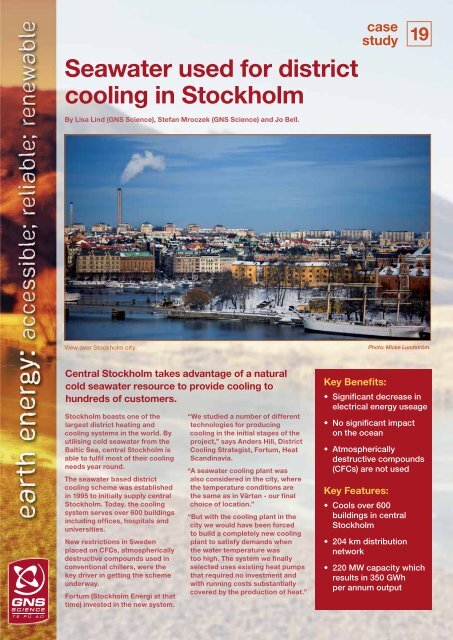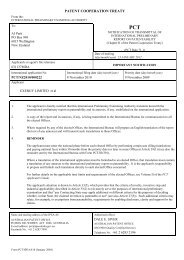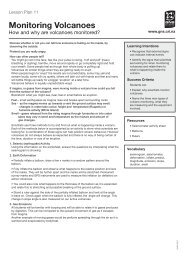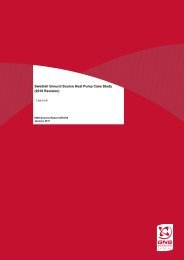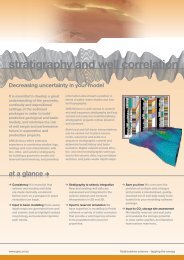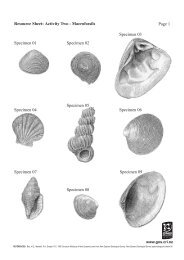Seawater used for district cooling in Stockholm - GNS Science
Seawater used for district cooling in Stockholm - GNS Science
Seawater used for district cooling in Stockholm - GNS Science
You also want an ePaper? Increase the reach of your titles
YUMPU automatically turns print PDFs into web optimized ePapers that Google loves.
<strong>Seawater</strong> <strong>used</strong> <strong>for</strong> <strong>district</strong><br />
<strong>cool<strong>in</strong>g</strong> <strong>in</strong> <strong>Stockholm</strong><br />
By Lisa L<strong>in</strong>d (<strong>GNS</strong> <strong>Science</strong>), Stefan Mroczek (<strong>GNS</strong> <strong>Science</strong>) and Jo Bell.<br />
Key Benefits:<br />
case<br />
study 19<br />
View over <strong>Stockholm</strong> city. Photo: Micke Lundström.<br />
Central <strong>Stockholm</strong> takes advantage of a natural<br />
cold seawater resource to provide <strong>cool<strong>in</strong>g</strong> to<br />
hundreds of customers.<br />
<strong>Stockholm</strong> boasts one of the<br />
largest <strong>district</strong> heat<strong>in</strong>g and<br />
<strong>cool<strong>in</strong>g</strong> systems <strong>in</strong> the world. By<br />
utilis<strong>in</strong>g cold seawater from the<br />
Baltic Sea, central <strong>Stockholm</strong> is<br />
able to fulfil most of their <strong>cool<strong>in</strong>g</strong><br />
needs year round.<br />
The seawater based <strong>district</strong><br />
<strong>cool<strong>in</strong>g</strong> scheme was established<br />
<strong>in</strong> 1995 to <strong>in</strong>itially supply central<br />
<strong>Stockholm</strong>. Today, the <strong>cool<strong>in</strong>g</strong><br />
system serves over 600 build<strong>in</strong>gs<br />
<strong>in</strong>clud<strong>in</strong>g offices, hospitals and<br />
universities.<br />
New restrictions <strong>in</strong> Sweden<br />
placed on CFCs, atmospherically<br />
destructive compounds <strong>used</strong> <strong>in</strong><br />
conventional chillers, were the<br />
key driver <strong>in</strong> gett<strong>in</strong>g the scheme<br />
underway.<br />
Fortum (<strong>Stockholm</strong> Energi at that<br />
time) <strong>in</strong>vested <strong>in</strong> the new system.<br />
“We studied a number of different<br />
technologies <strong>for</strong> produc<strong>in</strong>g<br />
<strong>cool<strong>in</strong>g</strong> <strong>in</strong> the <strong>in</strong>itial stages of the<br />
project,” says Anders Hill, District<br />
Cool<strong>in</strong>g Strategist, Fortum, Heat<br />
Scand<strong>in</strong>avia.<br />
“A seawater <strong>cool<strong>in</strong>g</strong> plant was<br />
also considered <strong>in</strong> the city, where<br />
the temperature conditions are<br />
the same as <strong>in</strong> värtan - our f<strong>in</strong>al<br />
choice of location.”<br />
“But with the <strong>cool<strong>in</strong>g</strong> plant <strong>in</strong> the<br />
city we would have been <strong>for</strong>ced<br />
to build a completely new <strong>cool<strong>in</strong>g</strong><br />
plant to satisfy demands when<br />
the water temperature was<br />
too high. The system we f<strong>in</strong>ally<br />
selected uses exist<strong>in</strong>g heat pumps<br />
that required no <strong>in</strong>vestment and<br />
with runn<strong>in</strong>g costs substantially<br />
covered by the production of heat.”<br />
• Significant decrease <strong>in</strong><br />
electrical energy useage<br />
• No significant impact<br />
on the ocean<br />
• Atmospherically<br />
destructive compounds<br />
(CFCs) are not <strong>used</strong><br />
Key Features:<br />
• Cools over 600<br />
build<strong>in</strong>gs <strong>in</strong> central<br />
<strong>Stockholm</strong><br />
• 204 km distribution<br />
network<br />
• 220 MW capacity which<br />
results <strong>in</strong> 350 GWh<br />
per annum output
Pipes are placed <strong>in</strong>to the water body. Photo: Eddie Granlund Photo: Micke Lundström<br />
Pipe tunnel <strong>for</strong> the<br />
<strong>district</strong> <strong>cool<strong>in</strong>g</strong> system.<br />
The <strong>cool<strong>in</strong>g</strong> system <strong>in</strong> <strong>Stockholm</strong><br />
differs from other lake/sea sourced<br />
<strong>cool<strong>in</strong>g</strong> systems as it <strong>in</strong>cludes heat<br />
pumps that are <strong>used</strong> to cool the<br />
seawater further if required, which<br />
usually occurs <strong>in</strong> autumn.<br />
In <strong>Stockholm</strong> it is possible to<br />
source water which is cool most<br />
of the year (m<strong>in</strong>us the period <strong>in</strong><br />
autumn) from very shallow depths.<br />
“The fresh water has lower<br />
density than the salt water, so<br />
the fresh water ‘floats’ on top of<br />
the salt water on its way through<br />
the archipelago and out <strong>in</strong>to the<br />
Baltic sea. The counter current<br />
carries cold sea-bed water to our<br />
<strong>district</strong> <strong>cool<strong>in</strong>g</strong> system.”<br />
“The water reach<strong>in</strong>g the <strong>in</strong>let of<br />
the <strong>cool<strong>in</strong>g</strong> plant <strong>in</strong> July left the<br />
surface of the archipelago <strong>in</strong> April<br />
where the water temperature was<br />
extremely low due to ice melts at<br />
that time.”<br />
Two sea water <strong>in</strong>lets feed the<br />
<strong>cool<strong>in</strong>g</strong> plant, located 4 km from<br />
the city; one on the sea bed at<br />
20 m depth and one at the surface.<br />
Anders says that this is very<br />
shallow, especially when compared<br />
to deep water systems which can<br />
require over 1000 m depth to reach<br />
sufficiently cold water.<br />
New Zealand requires reliable, renewable energy sources <strong>in</strong>to the<br />
future. The Government is support<strong>in</strong>g <strong>GNS</strong> <strong>Science</strong> <strong>in</strong> foster<strong>in</strong>g<br />
<strong>in</strong>creased use of renewable resources. By 2025, the Government’s<br />
Energy Strategy aims <strong>for</strong> direct use of geothermal energy to<br />
account <strong>for</strong> more than 12 PJ/year.<br />
For more <strong>in</strong><strong>for</strong>mation visit our website:<br />
www.gns.cri.nz/earthenergy<br />
After pass<strong>in</strong>g six titanium heat<br />
exchangers the waste water is<br />
either returned to the heat pumps<br />
or is released back <strong>in</strong>to the sea.<br />
The cool water is pumped 4 km to<br />
central <strong>Stockholm</strong> then through<br />
the city’s distribution network.<br />
“A significant benefit was the<br />
ability to make use of the ma<strong>in</strong>ly<br />
exist<strong>in</strong>g culvert system <strong>for</strong><br />
distribution with<strong>in</strong> the city.”<br />
With 220 MW of <strong>in</strong>stalled capacity<br />
and 350 GWh per annum output<br />
(2011), the <strong>cool<strong>in</strong>g</strong> system<br />
provides a significant sav<strong>in</strong>g <strong>in</strong><br />
electrical energy.<br />
“<strong>Stockholm</strong>’s situation is unique.<br />
Sufficiently cold water is available<br />
at very shallow depths almost all<br />
year round. In more mild climates<br />
greater depths <strong>for</strong> <strong>in</strong>lets of about<br />
750 m to 1000 m would have to be<br />
achieved, <strong>in</strong>creas<strong>in</strong>g capital costs.<br />
“But the use of seawater as a<br />
source of <strong>cool<strong>in</strong>g</strong> <strong>in</strong> more mild<br />
areas is still a promis<strong>in</strong>g option.<br />
As examples of this, there is one<br />
system designed <strong>in</strong> Hawaii and yet<br />
another one <strong>in</strong> Bahamas that is<br />
under consideration right now. ”<br />
or contact us:<br />
Wairakei Research Centre<br />
114 Karetoto Road,<br />
Wairakei 3377<br />
Private Bag 2000,<br />
Taupo 3352<br />
New Zealand<br />
Phone: +64 7 374 8211<br />
Email: earthenergy@gns.cri.nz<br />
“A SIGNIFICANT<br />
BENEFIT WAS THE<br />
ABILITy TO MAKE<br />
USE OF THE MAINLy<br />
ExISTING CULvERT<br />
SySTEM FOR<br />
DISTRIBUTION WITHIN<br />
THE CITy.”<br />
Anders Hill<br />
District Cool<strong>in</strong>g Strategist<br />
Fortum Power and Heat AB<br />
Phone: +46 (0)8 671 7000<br />
Email: kundservice.varme@<strong>for</strong>tum.com<br />
Website: www.<strong>for</strong>tum.com


